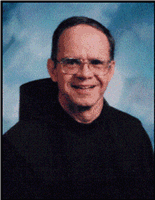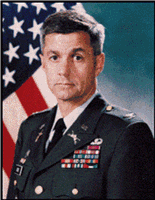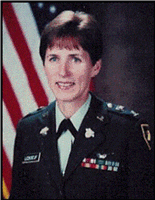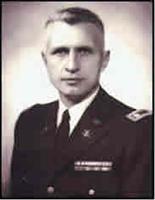2001 ROTC Hall of Fame Inductees
Rev. Bernard R. Creighton, O.F.M., Battalion Chaplain, Class of 1961

Father Bernard R. Creighton, O.F.M. is the son of Stanley J. and Helen M. (Palizay) Creighton. Born on 7 December 1939, he shares Elmira, New York origins with Army ROTC Hall of Fame charter member Brig. Gen. (Ret) Joseph L. Nagel '56.
He was graduated from St. Peter and Paul's (1953) and Notre Dame High School, Elmira in 1957, and enrolled as a freshman journalism student at St. Bonaventure University in 1957.
He was an ROTC student and member of the corps of cadets during his first two collegiate years before earning his bachelor of arts in journalism in 1961. A year later, Creighton entered the Franciscan Friars Holy Name Province. He professed Solemn Vows in the Franciscan Order in 1966, and was ordained a Catholic priest in 1967.
Father Bernard served in the Vocation Office of Holy Name Province, edited the Provincial Annals historical magazine and served on the staff of St. Joseph Seraphic Seminary in Callicoon, New York.
He served at St. Bonaventure University for 22 years as the executive secretary of the world-renowned Franciscan Institute. In this capacity, his contributions to the Institute's printing, publishing and business operations helped to maintain the Institute's reputation, along with Assisi, as the center for studying the life of St. Francis of Assisi.
Upon the death of their Chaplain, Father David Sweeney in 1993, ROTC cadets approached "Father Bernie," and asked him to accept the responsibility of becoming their next chaplain. He graciously accepted, and since that time, has offered reflective invocations and benedictions at nearly every cadet activity, from the military ball, to awards ceremonies, and has continued the time-honored tradition of blessing their second lieutenant bars at the commissioning ceremony.
In the tradition of Hall of Fame members Father David and Father Dominic Ternan '37, Father Bernie has been a chaplain to men and women who seek wisdom and grace in fulfilling their responsibilities to their Nation.
In his present post of Vicar of St. Anthony Friary in Butler, New Jersey, Father Bernard assists the Guardian in the care of the resident friar community. He serves as a weekend assistant at St. James Church, Red Bank, New Jersey, as well as a weekday Mass assistant at St. Anthony's Church, Butler, New Jersey, and at Our Lady of Mount Carmel Church, Boonton, New Jersey.
He is a past recipient of St. Bonaventure University's Mark Hellinger Award, and is a Fourth Degree member of the Knights of Columbus. He is honored to have two uncles who were active duty U.S. Army Air Corps members in World War II. Lawrence Creighton, St. Bonaventure Class of 1939, trained glider pilots at Twenty-nine Palms, California and in Florida. Donald Ripley flew combat missions in the European Theatre.
A cousin, U.S. Air Force Lieut. Col. (Ret) Robert J. Levanduski served in intelligence communications on Taiwan during the Vietnam War.
Always aware of the University Army ROTC program's need for young men and women of high academic, physical and spiritual qualities, Father Bernard continues to identify suitable candidates for the program, and has achieved the legacy of being a well-respected and highly likeable member of the University's ROTC family.
Brig. Gen. Paul S. Izzo, Class of 1975

Born on 22 October 1953 in Saratoga Springs, New York, Paul S. Izzo earned a bachelor of business administration degree and was commissioned as an armor second lieutenant through St. Bonaventure University's Army ROTC program in 1975.
Upon completing the Armor officer Basic Course, he was assigned as a tank platoon leader in the 1st Infantry Division, Fort Riley, Kansas. Following assignments as a company executive officer and battalion maintenance officer, he graduated from the Armor Officer Advanced Course and was ordered to Germany in 1980.
As a captain in Germany, he was an assistant brigade S3 before he commanded a tank company in the 2nd Battalion, 37th Armor, 1st Armored Division. He also was that battalion's operations officer before he returned to the U.S. to attend the Materiel Acquisition Management Course.
Assigned next to Aberdeen Proving Ground, Maryland, he was deputy secretary of the general staff and aide-de-camp before becoming a Bradley and M1A1 live fire test officer. In 1987, he earned a master's of business administration from Central Michigan University, and he graduated from the Command and General Staff College in 1989.
In 1989, he returned to Fort Riley as the operations officer of the 3rd Battalion, 37th Armor, 1st Infantry Division, with whom he deployed to Southwest Asia in 1990. Izzo's battalion created the breach in Iraqi defenses during Operation Desert Storm in February 1991, and as a tank commander, he led the battalion task force through the extensive minefields and trenches that made up the Iraqi position.
The 3-37 Armor later secured the airfield near Safwan, Iraq, allowing Gen. H. Norman Schwarzkopf to conduct peace negotiations with an Iraqi delegation of officers that ultimately ended the Persian Gulf War. For his contributions to the victory, Izzo earned two Bronze Stars, one of which was for Valor.
Izzo returned to the U.S. and was named to a one-year fellowship as a liaison officer between the Pentagon and Capitol Hill. In 1993, he was project manager for Constructive Simulations at STRICOM in Orlando, Florida, where he played a key role in developing the concept for WARSIM 2000.
He returned to the Pentagon in 1996, where he served as the executive officer to the Military Deputy to the Assistant Secretary of the Army (Research, Development and Acquisition.)
As a colonel, Izzo assumed an integral responsibility for shaping the current and future Army when he became the project manager for Bradley Fighting Vehicle Systems (BFVS) at TACOM. In this capacity, he oversees the development, production, fielding and logistical support for the BFVS. He is also responsible for overseeing the concept and development of a future generation of fighting vehicles.
A graduate of the Defense Systems Management College and the U.S. Army War College, BG Izzo's awards and decorations include the Legion of Merit with Oak Leaf Cluster, Bronze Star with "V" device and Oak Leaf Cluster, five awards of the Meritorious Service Medal, Army Commendation Medal with Oak Leaf Cluster, Army Achievement Medal with Oak leaf Cluster, National Defense Service Medal, Southwest Asia Service Medal with three Service Stars, Army Service Ribbon, Overseas Service Ribbon, Saudi Arabian and Kuwaiti Liberation of Kuwait Medals, Army Staff Badge and Parachutist Badge.
BG Izzo and his wife, Kathleen, have four children, Amy, Paul Jr., Stephen and Matthew.
Brig. Gen. (Ret.) Maureen K. LeBoeuf, Class of 1976

Maureen K. LeBoeuf was born on 7 December 1953 to Prof. and Mrs. Leo E. Keenan, Jr. in Olean, New York. She graduated from St. Bonaventure University, where she earned a bachelor of science in education in 1976.
As a student, she took Army ROTC classes through the Department of Military Science, but ultimately earned her commission through the Army’s College Junior Program, which was a commissioning source for women officers prior to the admission of women into ROTC or the U.S. Military Academy.
Receiving a direct commission as a second lieutenant in the Women’s Army Corps, she completed the Women’s Officer Basic Course at Fort McClellan, Alabama and after completing the Ordnance Officer Basic Course, was detailed to the Ordnance Corps.
LeBoeuf was assigned to Fort Eustis, Virginia in 1977, where she was the assistant S4, 7th Transportation Group and later a platoon leader and executive officer in the 558th Transportation Company (Floating Craft General Support.)
In 1980, LeBoeuf graduated from the U.S. Army Rotary Wing Course at Fort Rucker, Alabama, and earning her aviator’s wings, was assigned as executive officer and platoon leader, B Company, 394th Transportation Battalion (Aviation Maintenance), Nellingen, Germany. She also served as the battalion’s S1/adjutant and as a UH-1/UH-60 platoon leader.
She graduated from the Transportation Officer Advanced Course in 1984 and was assigned to Fort McPherson, Georgia where she was an aviation maintenance officer in the Office of the Deputy Chief of Staff for Logistics, Forces Command. In 1986, she earned a master’s degree in education from the University of Georgia, and was assigned as an instructor in the Department of Physical Education, U.S. Military Academy at West Point, New York.
Upon completion of Command and General Staff College in 1989, LeBoeuf received orders to report to Fort Carson, Colorado, where she was assigned in the 4th Infantry Division as adjutant/S1 of the 4th Aviation Brigade, assistant division aviation officer and S3 for plans, operations and training.
She earned a doctorate in education from the University of Georgia in 1994, and then returned to the U.S. Military Academy as an associate professor and director of instruction in the Department of Physical Education.
In 1997, LeBoeuf graduated from the U.S. Army War College. Promoted to colonel, she became professor and head of the Department of Physical Education at the U.S. Military Academy. The first woman to head a department at West Point since its founding in 1802, LeBoeuf has taught courses ranging from Advanced Close Quarters Combat to Unit Fitness to Downhill Skiing.
Her position carries the unique title
Master of the Sword, and she has published articles in scholarly, professional, military and popular publications. She has served on a wide variety of committees at West Point and has been involved in many aspects of cadet development and training.
She is a member of the U.S. and New York State Alliances of Health, Physical Education, Recreation and Dance, and has been active in her community, teaching religious education and serving as a lay Eucharistic minister.
BG LeBoeuf’s awards and decorations include the Meritorious Service Medal with Oak Leaf Cluster, four awards of the Army Commendation Medal, Army Achievement Medal, National Defense Service Medal, Army Service Ribbon, Overseas Service Ribbon and the Army Aviator Badge.
BG LeBoeuf and her husband, Col. Joseph N.G. LeBoeuf, Jr. have two children, Joseph and Jacqueline.
2000 ROTC Hall of Fame Inductees
Lt. Col (Ret.) USAF Leo E. Keenan Jr., Class of 1947
.gif?sfvrsn=6918773_2)
Born in Olean, New York, Leo E. Keenan, Jr. enlisted in the United States Naval Reserve and trained as a destroyer crew member in 1939.
His family, which had moved to Buffalo, returned to Olean in 1940, and Keenan received a discharge from the Navy in order to enroll in St. Bonaventure College's Army Reserve Officer Training Corps program. From 1940 until 1943, Keenan was a student and ROTC cadet at St. Bonaventure.
Upon completion of his junior year, his entire ROTC class was called to active duty, and Keenan reported to Fort Bragg, North Carolina, where he completed the Field Artillery Basic Training Course.
Corporal Keenan was ordered to return to St. Bonaventure and assigned to temporary duty at the College. He requested a release from his commitment to the Field Artillery branch in order to volunteer for service in the U.S. Army Air Corps, which was an arm of the Army at the time.
The professor of military science made the required arrangements, and by January 1944, Keenan had been released for assessment and subsequent training as an Army Air Corps officer candidate.
He reported to Nashville, Tennessee for classification, then was assigned to Maxwell Army Air Base for pre-flight training. On 30 September 1944, Keenan was commissioned a second lieutenant in the Army Air Corps as a bombardier. Almost immediately, Lieutenant Keenan was ordered to Hondo, Texas for additional flight training as navigator.
Upon earning his second flight crew certification in February 1945, this time as a navigator, he reported to Greenville Army Air Base, Greenville, South Carolina for B-25 "Mitchell" transition training. His flight experience with the B-25 eventually brought him to Hamilton Air Force Base and a point of embarkation, but the surrender of the Japanese in August 1945, forced the Air Corps to revoke his orders. He was assigned to stateside duty until December 1945.
Upon his release from active duty, Keenan returned to St. Bonaventure, where he completed his bachelor of arts degree in 1947. He earned his master's degree at Cornell University and, after teaching English at Niagara University for one year, returned to St. Bonaventure to begin a teaching career that would ultimately span 50 years.
He remained a member of the United States Air Force Reserve, serving as the adjutant of a Western New York based squadron, and as a captain was selected to serve as a regional liaison to the newly established United States Air Force Academy. In this capacity, he served until his retirement as a lieutenant colonel in 1981.
Keenan coordinated the Academy's presence with educators and high school students in 14 southwestern New York school districts, and helped to ensure the region's representation at one of the Nation's most prestigious educational institutions.
Throughout his tenure as a member of the faculty, Professor Keenan counseled the Army ROTC cadets who enrolled in his popular public speaking course. A constant voice in support of Army ROTC, he was elected to the University's first board of military evaluation and has remained a member through four decades, ensuring a sense of tradition in the formation of the lieutenants who have earned their commissions from St. Bonaventure.
Lieutenant Colonel Keenan's military awards include the Air Force Commendation Medal, the Air Force Reserve Medal with oak leaf cluster, the Good Conduct Medal, the American Campaign Medal, the WW II Victory Medal and the Presidential Unit Citation.
1st. Lt. Thomas D. "Tim" Moore, Class of 1940
-moorec01e046982374a45b9f2f1d2d6d15378.gif?sfvrsn=26582c06_0)
Thomas D. Moore was born to Mr. and Mrs. John D. Moore on 15 August 1918 in Olean, New York. He graduated from Olean High School in 1936 and joined the newly formed Army Reserve Officer Training Corps (ROTC) program as a freshman at St. Bonaventure College.
He graduated from St. Bonaventure with a Bachelor of Arts in sociology in 1940, and earned a commission as a second lieutenant of field artillery in the U.S. Army Reserve. The need to supplement the peacetime Army with officers had not arisen, and Moore took a job at the Bell Aircraft Corporation in Buffalo, New York.
A telegram on Jan. 1, 1942, however, informed him of the requirement to report for active duty, and he was transferred to the active component on 14 January 1942.
Reporting to Fort Bragg, North Carolina, Lieutenant Moore received additional instruction at Fort Jackson, South Carolina before completing the Field Artillery Officer's Basic Course at Fort Sill, Oklahoma.
He participated in desert maneuvers in Arizona, was then sent to Camp Pickett, Virginia and at Norfolk, Virginia, completed an intensive program of instruction in amphibious warfare. Finally, he reported to Fort Meade, Maryland to await transfer to the European Theatre of Operations.
A member of the 101st Airborne Division's 907
th Glider Field Artillery Battalion, Moore arrived in England in May 1944. He was assigned as a forward observer and spent that summer training with glider and parachute troops. On 17 September, he entered combat aboard a glider, participating in the largest and most daring airborne operation of the War, Operation Market Garden.
The 101
st Airborne, along with other Allied units, liberated several Dutch towns and Moore fought in a series of fierce engagements against stubborn German forces. After 72 consecutive days of combat, Moore and his comrades were relieved and allowed to refit near Mourmelon-le-Grand, France on 28 November 1944.
By the night of 17 December, the Germans were making an unexpected counteroffensive into a part of the Allied line that would come to be known as the Battle of the Bulge. Moore and nearly 12,000 other "Screaming Eagles" traveled 107 miles in open trucks and mounted a defense near the strategically important town of Bastogne, Belgium.
Engaged without rest for nearly two days, Lieutenant Moore was directing artillery fires for the heavily outnumbered division when he decided that he was not getting the results he wanted. Determining he could better complete his mission from a different point, he crossed a railroad embankment to occupy a new position. Soon after, however, a mortar shell landed in close proximity to him, and a fragment struck Moore, killing him instantly.
In recognition of the decision he made, without regard to his own safety, First Lieutenant Moore was posthumously awarded the Purple Heart and the Silver Star - one of the Nation's highest awards for valor. He was initially interred near Verdun, France, but at the request of his mother, his body was moved to the St. Bonaventure Cemetery, where he rests as one of the heroes of World War II.
Col. (Ret.) Vernon R. Rottstedt, Class of 1940

Born in Olean, New York, Vernon R. Rottstedt began at St. Bonaventure College on a football scholarship, graduating in 1940 with a Bachelor of Arts degree. Although he had taken the Colleges prescribed ROTC course of instruction, he was commissioned before completing its requirements under the provisions of the Tomlinson Act of 1939 and became the first St. Bonaventure officer to be commissioned into the Regular Army.
Completing the Field Artillery Officer Basic Course, he was assigned to the First Infantry Division and spent World War II with the "Big Red One." As commander of Battery A, 5
th Field Artillery Bn., near Gela, Sicily on 11 July 1943, Captain Rottstedt earned the Silver Star for gallantry in action when German tanks attacked his observation post, severely wounding his instrument sergeant.
He administered first aid and then carried the wounded man, over terrain swept by heavy artillery and small arms fire, to the battery position. He then established a new OP and continued to fire on the enemy until they withdrew.
His heroic action undoubtedly saved the life of the wounded man and his courage and determination in the face of the enemy tank attack aided materially in securing the division beachhead. His combat service continued, as he landed on D+3 at Normandy and served throughout the European Theatre until the end of the War.
In 1945, Rottstedt graduated from the Officer's Refresher Course at Fort Sill, Oklahoma. He graduated from the Artillery Officer Advanced Course in 1951, and served in Turkey until 1952. He completed the AAA & Guided MSL Course at Fort Bliss, Texas in 1953.
Rottstedt graduated from the Command & General Staff College in 1959, whereupon he once again served in an overseas assignment, assisting in the selection of NIKE Hercules missile sites and conducting annual service practice for air defense units in Hawaii and Taiwan.
He attained the rank of colonel on 2 October 1964.
A Distinguished Member of the 5
th Artillery Regiment, Rottstedt maintained his affiliation with that organization after his retirement, earning a certificate of achievement from the 1
st Battalion, 5
th Field Artillery (Fort Riley, Kansas) for support of that organization's families during Operation Desert Storm in 1991.
His awards and decorations include the Silver Star, Legion of Merit, Commendation Ribbon with Metal Pendant, Army Commendation Medal with oak leaf cluster, National Defense Service Medal, American Campaign Medal, Europe-Africa-Middle East Campaign Medal with arrowhead device and three campaign stars and the World War II Victory Medal.